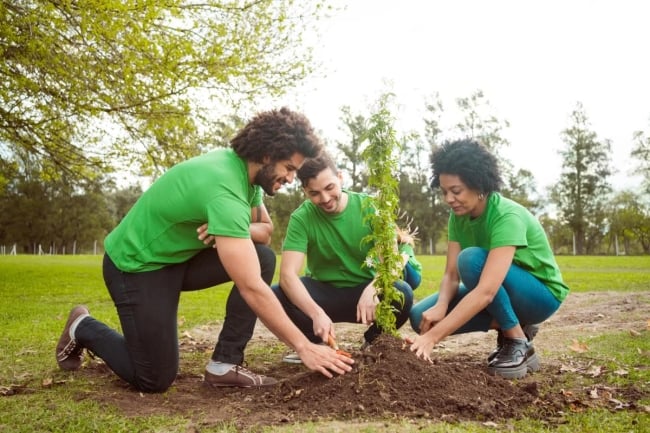You have /5 articles left.
Sign up for a free account or log in.

Students can take part in local government initiatives related to areas such as tree planting, bicycle transportation planning, energy use and nature conservation.
izusek/E+/Getty Images
Higher education professionals have long been concerned with how to raise public awareness about climate change. Yet today we face a different problem. Confronted with the apocalyptic climate narrative dominating popular media, ignorance has been replaced by a gripping fear of the future, particularly among young people. This narrative is not only bad for our students’ mental health, it is also an ineffective strategy for building a lasting movement for change. Fortunately there are practical steps that colleges can take to make climate action compatible with personal well-being.
A recent Student Voice survey on sustainability opinions and experiences found that 42 percent of 2,164 student respondents are “very worried” and another 39 percent “somewhat worried” about climate change. These findings, from a survey conducted by Inside Higher Ed and College Pulse and sponsored by Kaplan, are consistent with research literature on climate anxiety, which is especially prominent among younger adults. The problem is not that our students are concerned; critical reflection on the world’s problems does, after all, require emotional work. The problem is that many young people feel helpless to change the situation and sense that the world is heading inexorably toward a future of doom and destruction.
[block:block=176]
This apocalyptic narrative has a long history in the environmental movement and within academia. The book The Limits to Growth galvanized concern worldwide with its publication in 1972, as the authors associated with the Club of Rome wrote, “The crux of the matter is not only whether the human species will survive, but even more whether it can survive without falling into a state of worthless existence.” In today’s media environment, the rhetoric of doom is only a click away. A headline from New York magazine in 2018 is representative, proclaiming, “UN Says Climate Genocide Is Coming. It’s Actually Worse Than That.”
Effective social action must be based on a plausible model of social change. Purveyors of the apocalyptic narrative seem to believe that if we could just frighten people a little bit more, filling their dreams with fires and floods and the extinction of life on earth, people will finally be motivated to act.
This theory of action carries privileged and potentially harmful assumptions about the psychological disposition of the audience for these messages. Marginalized communities and those whose daily lives include exposure to poverty, violence, racism, incarceration, gender discrimination and anti-LGBTQ bias are already subject to chronic psychological stress.
More generally, research shows that fear has only limited power in inspiring action. Our students must also have a sense of hope and efficacy—the notion that they can actually have an impact on the world. Fortunately college campuses, whose leaders and educators are acutely aware of the growing need to support student mental health, can take concrete steps to advance both goals:
- Support community engagement. One of the surest ways to build a sense of self-efficacy among students is to incorporate community engagement experiences in the curriculum. In practice, these experiences require a level of administrative and logistical effort that is difficult for faculty to manage. Universities can support these initiatives with dedicated staff who can identify community partners, arrange field visits, and sustain the long-term partnerships required for effective community collaborations.
- Partner with local governments. Given the current political atmosphere, it is not difficult to see why 74 percent of respondents in the Student Voice survey feel the federal government is doing too little to address climate change. But local governments have significant influence over policies affecting climate change—from bicycle transportation planning to housing density, tree planting, energy use and nature conservation. These are decision-making processes that students can witness firsthand and even influence. The next time a student club suggests relabeling the recycling bins on campus, faculty and administrators can provide opportunities for students have a larger impact by partnering with city staff, providing data analysis and other forms of support. Smaller cities (where most people in the U.S. and the world live) are chronically understaffed and lack basic information about transportation needs, the location of endangered habitats and citizen preferences regarding housing, water use and energy.
- Place climate in a broader context. As authors like Hans Rosling and Steven Pinker have pointed out, humanity is better off by most measures—wealth, child mortality, education levels and more—than at any point in modern history. Within the life span of today’s undergraduates, global poverty has been cut in half. Teaching our students that climate change will have very serious negative consequences is a necessity. Telling them that the future human condition will be fundamentally worse than the present is hyperbole.
- Teach social change. We must help students to understand that social change is not only possible—it is pervasive. Alongside discussions of environmental catastrophes—and there are many—students can appreciate the possibility for change by studying success stories, from our dramatic improvements in air quality, to the removal of lead from gasoline, the flourishing of private land trusts and the rapid growth of sustainable buildings and alternative energy sources. The “sweet spot” for fostering a sense of efficacy is to show that these changes were neither impossible nor inevitable. As with other social movements, it took the application of creativity and hard work to bring about change.
- Shift the narrative. The most compelling promise offered by the apocalyptic narrative is this: we are heading toward doom, but if we act now we can make things a bit less doomlike. Surely educators can do better than this. Curricular modules and research initiatives that explore win-win solutions—addressing climate change while providing other tangible benefits—can offer up a vision of a better world.
Policies to reduce fossil fuel consumption will improve community health outcomes at a speed and scale that would likely not have occurred without the sense of urgency attending climate policy. Expanded opportunities for forest conservation to sequester carbon have already provided far more financing for biodiversity conservation than would otherwise have been possible. Urban infrastructure for cycling and walking increases recreational opportunities, enhances public health and reduces accidents. Policies empowering Indigenous communities with greater control over ancestral lands can simultaneously advance human rights and climate agendas.
To effectively address climate change will require sustained citizen action over a time scale of decades. If we hope to inspire our students to participate in this effort, we must pay attention not only to carbon dioxide levels in the air, but to stress levels on our campuses. As a new generation reflects on its place in the world, shifting the climate narrative from apocalypse to empowerment is more likely to achieve a positive outcome for both people and the planet.




